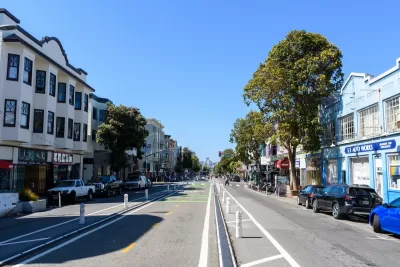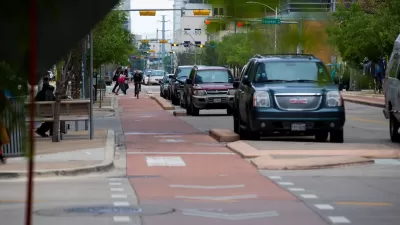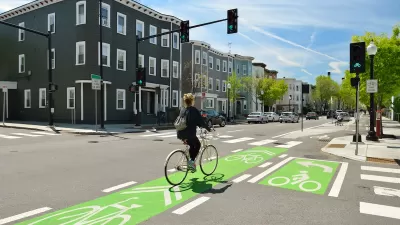A local bike safety protest has become a global phenomenon.

A road safety protest dubbed People Protected Bike Lanes (PPBL) is helping spur action and improve road safety in San Francisco and far beyond, writes Roger Rudick in Streetsblog San Francisco.
The movement, which started in 2017, involves demonstrations “in which participants stand on the street in a line between cyclists and car traffic to demonstrate the inadequacy of existing bicycle infrastructure.”
According to a study from NYU researcher Marcel Moran, “At the close of 2023, 32 of the 55 locations (58 percent) where PPBL took place have had protected bike lanes installed.” Moran attributes the protests’ success in part to their non-combative nature. “They instantly convey what the demonstration is asking for, they show bravery on the part of the participants, but they don't actually delay anybody except perhaps the minority of drivers who were attempting to park illegally on the block, he explained.”
Moran adds, “PPBL represents one of the latest forms of bicycle demonstrations, joining a long history of activism that stretches back decades in both Europe and the United States. For example, Amsterdam’s transition to one of the world’s most bike-friendly cities, including expansive bicycle infrastructure and restrictions on cars, was significantly influenced by consistent protests.”
FULL STORY: Study: People Protected Bike Lanes Made a Difference

Manufactured Crisis: Losing the Nation’s Largest Source of Unsubsidized Affordable Housing
Manufactured housing communities have long been an affordable housing option for millions of people living in the U.S., but that affordability is disappearing rapidly. How did we get here?

Americans May Be Stuck — But Why?
Americans are moving a lot less than they once did, and that is a problem. While Yoni Applebaum, in his highly-publicized article Stuck, gets the reasons badly wrong, it's still important to ask: why are we moving so much less than before?

Using Old Oil and Gas Wells for Green Energy Storage
Penn State researchers have found that repurposing abandoned oil and gas wells for geothermal-assisted compressed-air energy storage can boost efficiency, reduce environmental risks, and support clean energy and job transitions.

San Antonio Remains Affordable as City Grows
The city’s active efforts to keep housing costs down through housing reforms and coordinated efforts among city agencies and developers have kept it one of the most affordable in the nation despite its rapid population growth.

What Forest Service Cuts Mean for Cities
U.S. Forest Service employees work on projects that have impacts far beyond remote, rural wilderness areas.

North Texas Transit Leaders Tout Benefits of TOD for Growing Region
At a summit focused on transit-oriented development, policymakers discussed how North Texas’ expanded light rail system can serve as a tool for economic growth.
Urban Design for Planners 1: Software Tools
This six-course series explores essential urban design concepts using open source software and equips planners with the tools they need to participate fully in the urban design process.
Planning for Universal Design
Learn the tools for implementing Universal Design in planning regulations.
Heyer Gruel & Associates PA
City of Moreno Valley
Institute for Housing and Urban Development Studies (IHS)
City of Grandview
Harvard GSD Executive Education
Salt Lake City
NYU Wagner Graduate School of Public Service
City of Cambridge, Maryland





























